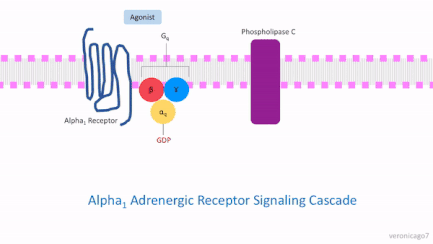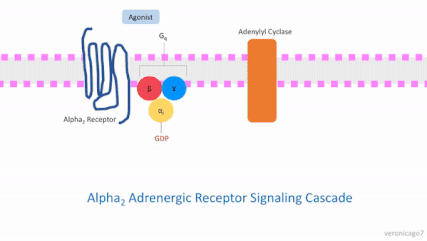Alpha blocker
| Alpha blockers α-blockers | |
|---|---|
Neutral antagonist | |
| Biological target | α-adrenoceptors |
| Legal status | |
| In Wikidata | |

Alpha-blockers, also known as α-blockers or α-adrenoreceptor antagonists, are a class of
Historically, alpha-blockers were used as a tool for pharmacologic research to develop a greater understanding of the autonomic nervous system. Using alpha blockers, scientists began characterizing arterial blood pressure and central vasomotor control in the autonomic nervous system.[3] Today, they can be used as clinical treatments for a limited number of diseases.[2]
Alpha blockers can treat a small range of diseases such as hypertension, Raynaud's disease, benign prostatic hyperplasia (BPH) and erectile dysfunction.[2] Generally speaking, these treatments function by binding an α-blocker to α receptors in the arteries and smooth muscle. Ultimately, depending on the type of alpha receptor, this relaxes the smooth muscle or blood vessels, which increases fluid flow in these entities.[2]
Classification

- α1-blockers act on α1-adrenoceptors
- α2-blockers act on α2-adrenoceptors
When the term "alpha blocker" is used without further qualification, it can refer to an α1 blocker, an α2 blocker, a nonselective blocker (both α1 and α2 activity), or an α blocker with some β activity.[2] However, the most common type of alpha blocker is usually an α1 blocker.
Non-selective α-adrenergic receptor antagonists include:
Selective α1-adrenergic receptor antagonists include:
Selective α2-adrenergic receptor antagonists include:
Finally, the agents carvedilol and labetalol are both α and β-blockers.
Below are some of the most common drugs used in the clinic.
| Drug Name | Common Brands | Structure | Mechanism of Action | Effects | Clinical Applications | Toxicity |
|---|---|---|---|---|---|---|
| Phenoxybenzamine | Dibenzyline | 
|
Nonselective covalent binding to α1 and α2 receptors. | Lowers blood pressure by decreasing peripheral resistance.
Blocks alpha induced vasconstriction.[2] |
|
|
| Phentolamine | Regitine | 
|
Competitive blocking of α1 and α2 receptors. | Reversal of epinephrine induced effects.
Lowers blood pressure by decreasing peripheral resistance.[2][10] |
| |
| Prazosin | Minipress | 
|
Competitive blocking of α1 receptor.[10] | Lowers blood pressure.[2] | ||
| Doxazosin | Cardura
Cardura XL |

|
Competitive blocking of α1 receptor.[10] | Lowers blood pressure.[2] |
|
|
| Terazosin | Hytrin | 
|
Competitive blocking of α1 receptor.[10] | Lowers blood pressure.[2] | ||
| Tamsulosin | Flomax | 
|
A blocker that has slight selectivity for α1 receptors.[2] | Relaxation of prostatic smooth muscle.[2] |
| |
| Yohimbine | Yocon | 
|
Blocks α2 receptor, and increases norepinephrine release, thus increasing CNS activity.[2] | Raises blood pressure and heart rate.[2] |
| |
| Labetalol | Trandate | 
|
Blocks some α1 receptor activity, but binds more strongly to β receptors.[2] | Lowers blood pressure, increases heart rate slightly.[2] |
| |
| Carvedilol | Coreg
Coreg CR |

|
Blocks some α1 receptor activity, but binds more strongly to β receptors.[2] | Can interfere with noradrenergic mechanisms.[2] |
|
|
Medical uses
While there are limited clinical α-blocker uses, in which most α-blockers are used for
Furthermore, α-blockers can occasionally be used to treat anxiety and panic disorders, such as
Hypertension
Another treatment for hypertension is using drugs that have both α1 blocking activity, as well as nonselective β activity, such as Labetalol or carvedilol.[19] In low doses, labetalol and carvedilol can decrease the peripheral resistance and block the effects of isoprenaline to reduce hypertensive symptoms.[19]
Pheochromocytoma

Pheochromocytoma is a disease in which a catecholamine secreting tumor develops.[2][20] Specifically, norepinephrine and epinephrine are secreted by these tumors, either continuously or intermittently.[21] The excess release of these catecholamines increases central nervous system stimulation, thus causing blood vessels to increase in vascular resistance, and ultimately giving rise to hypertension.[20] In addition, patients with these rare tumors are often subject to headaches, heart palpitations, and increased sweating.[2]
Phenoxybenzamine, a nonselective α1 and α2 blocker, has been used to treat pheochromocytoma.[21] This drug blocks the activity of epinephrine and norepinephrine by antagonizing the alpha receptors, thus decreasing vascular resistance, increasing vasodilation, and decreasing blood pressure overall.[21]
Congestive heart failure
Blockers that have both the ability to block both α and β receptors, such as
Erectile dysfunction
Phentolamine, a non-selective alpha blocker, has also been tested to treat erectile dysfunction. By reducing vasoconstriction in the penis, there appears to be increased blood flow that aids in penile erection. Side effects associated with phentolamine include headache, flushing, and nasal congestion.[23]

Phenoxybenzamine, a non-competitive α1 and α2 blocker was used by Dr. Giles Brindley in the first intracavernosal pharmacotherapy for erectile dysfunction.[24]
Benign prostatic hyperplasia
In benign prostatic hyperplasia (BPH), men experience urinary obstruction and are unable to urinate, thus leading to urinary retention.[2] α1 specific blockers have been used to relax the smooth muscle in the bladder and enlarged prostate.[25] Prazosin, doxazosin, and terazosin have been particularly useful for patients with BPH, especially in patients with hypertension.[2] In such patients, these drugs can treat both conditions at the same time.[2] In patients without hypertension, tamsulosin can be used, as it has the ability to relax the bladder and prostate smooth muscle without causing major changes in blood pressure.[25]
Raynaud's disease

Both α1 blockers and α2 blockers have been examined to treat Raynaud's disease. Although α1 blockers, such as prazosin, have appeared to give slight improvement for the sclerotic symptoms of Raynaud's disease, there are many side effects that occur while taking this drug. Conversely, α2 blockers, such as yohimbine, appear to provide significant improvement of the sclerotic symptoms in Raynaud's Disease without excessive side effects.[26]
Post traumatic stress disorder
Patients with
Adverse effects of prazosin to treat PTSD nightmares include
Adverse effects
Although alpha blockers have the ability to reduce some disease pathology, there are some side effects that come with these alpha blockers.[28] However, because there are several structural compositions that make each alpha blocker different, the side effects are different for each drug. Side effects that arise when taking alpha blockers can include the first dose effect, cardiovascular side effects, genitourinary side effects, as well as other side effects.[28]
First dose effect
One of the most common side effects with alpha blockers is the
Alpha blockers that possess these side effects include prazosin, doxazosin, and terazosin.[30]
Cardiovascular side effects
There are some alpha blockers that can give rise to changes in the cardiovascular system, such as the induction of reflex tachycardia, orthostatic hypotension, or heart palpitations via alterations of the QT interval.[28][31]
Alpha blockers that may have these side effects include yohimbine, phenoxybenzamine, and phentolamine.[2]
Genitourinary side effects
When alpha blockers are used to treat BPH, it causes vasodilation of blood vessels on the bladder and the prostate, thus increasing urination in general.[32] However, these alpha blockers can produce the exact opposite side effect, in which edema, or abnormal fluid retention, occurs.[33]
In addition, due to the relaxation of the prostate smooth muscle, another side effect that arises in men being treated for BPH is impotence, as well as the inability to ejaculate.[32][34] However, if any ejaculation activity does occur, oftentimes, it results in a phenomenon called retrograde ejaculation, in which semen flows into the urinary bladder instead of exiting through the urethra.[34]
Drugs that may produce such side effects include prazosin, terazosin, tamsulosin, and doxazosin.[34]
Other side effects
Finally, there are other general side effects that can be caused by most alpha blockers (however, more frequently in alpha-1 blockers). Such side effects include
Priapism, an unwanted, painful long term erection not brought on by sexual arousal and lasting several hours has been associated with alpha blocker use. While this is extremely rare, particularly with tamsulosin, it can cause permanent impotence if not treated in a hospital setting. Male patients should be made aware of this as it can result from a single dose or develop over time.
Contraindications
There is only one compelling indication for alpha blockers, which is for benign prostatic hyperplasia.[33] Patients who need alpha blockers for BPH, but have a history of hypotension or postural heart failure, should use these drugs with caution, as it may result in an even greater decrease in blood pressure or make heart failure even worse.[35][36] The most compelling contraindication is urinary incontinence and overall fluid retention.[35][36] To combat such fluid retention, patients can take a diuretic in combination with the alpha-blocker.[36]
In the absence of compelling indications or contraindications, patients should take alpha blockers as a step 4 therapy to reduce blood pressure, but only if the use of ACE inhibitors, angiotensin-II receptor blockers, calcium channel blockers, or thazide diuretics (in full dose or in combinations) have not been efficacious.[33][35][36]
Drug interactions
As with any drug, there are drug interactions that can occur with alpha blockers. For instance, alpha blockers that are used for the reduction of blood pressure, such as phenoxybenzamine or phentolamine can have synergy with other drugs that affect smooth muscle, blood vessels, or drugs used for erectile dysfunction (i.e. sildenafil, tamsulosin, etc.). This stimulates exaggerated hypotension.[2]
Alternative alpha blockers, such as prazosin, tamsulosin, doxazosin, or terazosin can have adverse interactions with beta blockers, erectile dysfunction drugs, anxiolytics, and antihistamines.[2] Again, these interactions can cause dangerous hypotension. Furthermore, in rare cases, drug interactions can cause irregular, rapid heartbeats or an increase blood pressure.[2]
Yohimbine can interact with stimulants, hypertension drugs, naloxone, and clonidine. Interactions with such drugs can cause either an unintended increase in blood pressure or potentiate an increase in blood pressure.[2]
Finally, in drugs with both alpha and beta blocking properties, such as carvedilol and labetalol, interactions with other alpha or beta blockers can exaggerate a decrease in blood pressure.[2] Conversely, there are also drug interactions with carvedilol or labetalol in which blood pressure is increased unintentionally (such as with cough and cold medications).[2] Finally, there may also be some alpha/beta blocker drug interactions that can worsen previous heart failure.[2]
Mechanism of action
Alpha blockers work by blocking the effect of nerves in the sympathetic nervous system. This is done by binding to the alpha receptors in smooth muscle or blood vessels.[37] α-blockers can bind both reversibly and irreversibly.[2]
There are several α receptors throughout the body where these drugs can bind. Specifically, α1 receptors can be found in most vascular smooth muscle, the pupillary dilator muscle, the heart, the prostate, and pilomotor smooth muscle.[2] On the other hand, α2 receptors can be found in platelets, cholinergic nerve terminals, some vascular smooth muscle, postsynaptic CNS neurons, and fat cells.[2]
The structure of α receptors is a classic
Because the α1 and α2 receptors have different mechanisms of action, their antagonists also have different effects.
 |
 |
|---|
See also
References
- ISBN 9780838505533.
- ^ ISBN 978-0-07-176402-5.
- PMID 6134533.
- S2CID 250307179.
- ^ S2CID 24619863.
- ^ S2CID 40069887.
- ^ "Tamsulosin Monograph for Professionals". Drugs.com. Archived from the original on 2021-01-20. Retrieved 29 January 2021.
- ^ S2CID 37160206.
- .
- ^ OCLC 34905985.
- PMID 16986054.
- PMID 3037926.
- PMID 10949.
- PMID 9330125.
- PMID 14767264.
- PMID 11691497.
- PMID 9649257.
- S2CID 251991.
- ^ S2CID 42161040.
- ^ S2CID 222084372.
- ^ .
- ^ PMID 10662755.
- ^ PMID 10853004.
- ISBN 978-1-84628-428-1, retrieved 2024-02-26
- ^ PMID 8647139.
- PMID 18656283.
- ^ PMID 24490030.
- ^ a b c d Manning, Loretta; Rayfield, Sylvia. Pharmacology Made Easy. Bossier City, LA: ICAN. p. 38.
- ^ PMID 6403103.
- ISBN 9780323039611.
- PMID 18660858.
- ^ PMID 18231614.
- ^ doi:10.1002/psb.779.
- ^ PMID 11074198.
- ^ a b c "Alpha-Adrenoceptor Antagonists (Alpha-Blockers)" (PDF). British Hypertension Society. Archived from the original (PDF) on 2017-08-29.
- ^ a b c d "CV Pharmacology | Alpha-Adrenoceptor Antagonists (Alpha-Blockers)". cvpharmacology.com. Retrieved 2017-11-15.
- ^ Knott, Laurence (2015-06-27). "Alpha-blockers". Patient.
- S2CID 23659116.
- S2CID 83827013.
